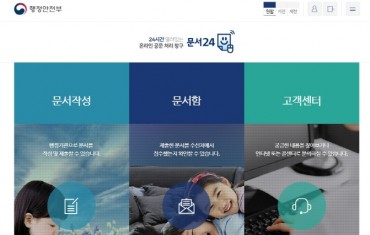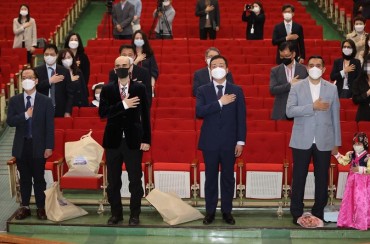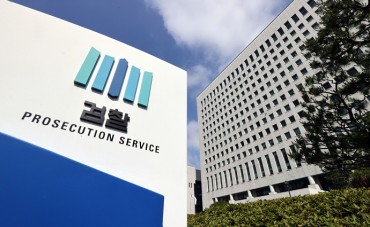
Travelers head to the departure hall of Jeju International Airport on the southern resort island of Jeju on Oct. 4, 2020. (Yonhap)
SEOUL, Oct. 4 (Korea Bizwire) — South Korea’s new coronavirus cases hovered below 100 for the fourth consecutive day on Sunday, but the daily tally may bounce back as millions of people traveled over the Chuseok fall harvest holiday.
The country added 64 more COVID-19 cases, including 47 local infections, raising the total caseload to 24,091, according to the Korea Disease Control and Prevention Agency (KDCA).
It marked a slight decrease from 75 cases reported on Saturday and a rise from 63 identified on Friday. After daily infections hit 133 on Wednesday, they have declined back to double-digit figures.
Sunday marks the end of the extended Chuseok autumn holiday that began on Wednesday. Millions of people traveled across the country to meet their family members and relatives over the Korean equivalent of Thanksgiving.
Health authorities designated Monday to Oct. 11 as a special two-week period for toughened virus curbs on concerns that new virus cases may resurge again due to the long holiday.
So far, only two people who visited the southeastern port city of Busan during the holiday have tested positive for the virus.
The country also has a three-day break from Oct. 9 to 11, when Hangeul Day, which celebrates the Korean alphabet, is combined with the weekend.
Despite the latest decrease in the number of new cases, the slowdown was in part attributable to fewer COVID-19 tests carried out during the holiday. More than 10,000 tests are normally carried out over weekdays, while they halved over the holiday.
Considering the incubation period of the virus, there could be a number of travelers who have not yet suffered symptoms of the virus as well.
Health Minister Park Neung-hoo told reporters that it is too early to say that local outbreaks have shown clear signs of stabilization.
With millions of people moving during the holiday season, there is a possibility that “silent spread” may have taken place, Park said.
The government can determine whether the holiday season has affected local outbreaks when test results come in the middle of this week, Park said.
South Korea plans to come up with more details for its social distancing guidelines following the deadline after keeping tabs on new coronavirus cases this week.
Over the past two weeks, 18.4 percent of newly added patients had unknown infection routes. Around 26.6 percent were traced to cluster infections as well, according to the latest data.

Seoul Station in central Seoul is filled with travelers on Oct. 4, 2020, the final day of the Chuseok holiday. (Yonhap)
The average number of daily new COVID-19 cases came to 66.5 over the past two weeks, down 54.4 from the two-week period earlier.
Of the newly identified local infections, 16 cases were reported in Seoul and 14 cases in Gyeonggi Province that surrounds the capital. Incheon, west of Seoul, reported five more cases.
Other municipalities reported new infections, with the country’s largest port city of Busan adding five cases and the central city of Daejeon reporting two new cases.
Cases traced to an art high school in western Seoul reached seven as of Sunday at noon, up six from the previous day. Six of them were staff members, and the other was one of their family members.
A hospital in Bucheon, west of Seoul, reported seven more patients, raising the related caseload to 11.
Cases traced to a factory in the southeastern port city of Pohang came to six, up five from a day earlier.
On Saturday, local authorities sealed off the Gwanghwamun area in central Seoul to prevent illegal protests.
The move came as an anti-government rally in central Seoul held in mid-August emerged as a hotbed for South Korea’s virus pandemic, with more than 600 infections being traced to the gathering.
Conservative groups staged “drive-thru” anti-government rallies in southern Seoul after winning court approval to hold demonstrations only under certain conditions to prevent another coronavirus resurgence from mass gatherings.
The country’s new virus cases had been in the triple digits for more than a month since Aug. 14, due mainly to cases tied to a church in northern Seoul and the anti-government rally. Daily infections soared to 441 on Aug. 27.
But new COVID-19 cases have slowed on the back of tightened social distancing rules. The country reported 38 new cases Tuesday, marking the first time that daily infections fell below 50 since Aug. 11.
Imported cases came to 17.
Of the imported cases, the Philippines and India accounted for three cases each. There were patients from Russia, Iran, Britain and the United States as well.
South Korea added one additional death, raising the death toll to 421.
The fatality rate reached 1.75 percent.
So far, there have been no deaths among patients aged 29 and below. More than 20 percent of the victims were aged 80 and above.
The number of patients in serious or critical condition came to 105, up one from the previous day.
The total number of people released from quarantine after making full recoveries stood at 21,845, up 58 from the previous day. More than 90 percent of the patients reported here have been cured.
South Korea has carried out 2,346,345 COVID-19 tests since Jan. 3, including 6,486 from the previous day.
(Yonhap)






